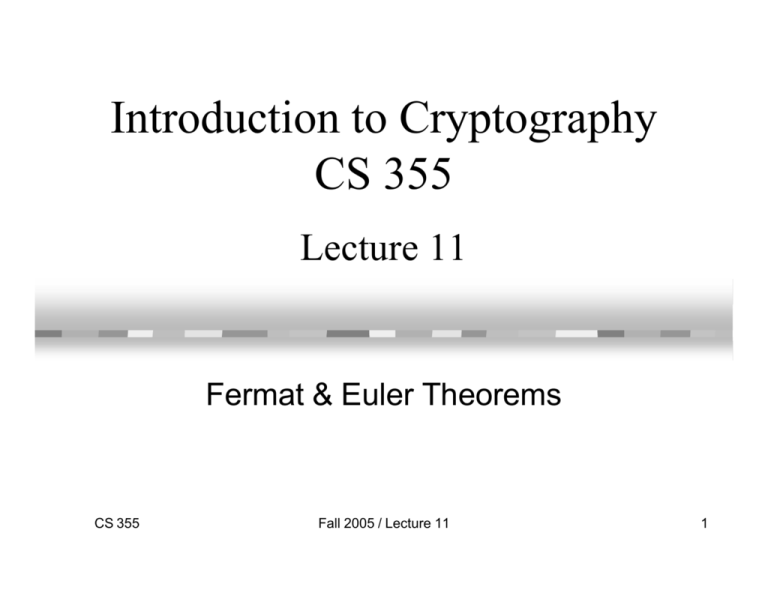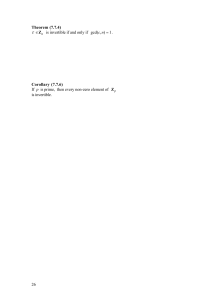Number Theory: Fermat & Euler
advertisement

Introduction to Cryptography
CS 355
Lecture 11
Fermat & Euler Theorems
CS 355
Fall 2005 / Lecture 11
1
Residue Classes
• Given positive integer n, congruence modulo n is
an equivalence relation.
• This relation partition all integers into equivalent
classes; we denote the equivalence class
containing the number x to be [x]n, or [x] when n
is clear from the context
• These classes are called residue classes modulo
n
• E.g., [1]7=[8]7={…, -13,-6,1,8,15,22,…}
CS 355
Fall 2005 / Lecture 11
2
Modular Arithmetic in Zn
• Define Zn as the set of residue classes modulo n
– Z7 = {[0], [1], [2], …, [6]}
• Define two binary operators + and × on Zn
• Given [x], [y] in Zn,
[x] + [y] = [x+y],
[x] × [y] = [xy]
• E.g., in Z7: [3]+[4] = [0], [0]+[2] = [2]+[0] = 2,
[5]+[6] = 4
• Compute the table for Z4
CS 355
Fall 2005 / Lecture 11
3
Properties of Modular Addition and
Multiplication
Let n be a positive integer and Zn be the set of residue
classes modulo n. For all a, b, c ∈ Zn
1. a + b = b + a
addition is commutative
2. (a+b)+c = a+(b+c)
addition is associative
3. a + [0] = a
exists addition identity
4. [x] + [–x] = [0]
exists additive inverse
5. a × b = b × a
multiplication is commutative
6. (a×b)×c = a×(b×c)
multiplication is associative
7. a×(b+c) = a×b+ a×c
mult. distributive over add.
8. a×[1] = [a]
exists multiplicative identity
CS 355
Fall 2005 / Lecture 11
4
Multiplicative Inverse
• Theorem: [x]n has a multiplicative inverse if and
only if gcd(x,n) = 1
• We use Zn* to denote the set of all residue
classes that have a multiplicative inverse.
• Zn* is closed under multiplication.
CS 355
Fall 2005 / Lecture 11
5
The Euler Phi Function
Definition
Given an integer n, Φ(n) = | Z n*| is the
number of all numbers a such that 0 < a
< n and a is relatively prime to n (i.e.,
gcd(a, n)=1).
Theorem:
If gcd(m,n) = 1, Φ(mn) = Φ(m) Φ(n)
CS 355
Fall 2005 / Lecture 11
6
The Euler Phi Function
Theorem: Formula for Φ(n)
Let p be prime, e, m, n be positive integers
1) Φ(p) = p-1
2) Φ(pe) = pe – pe-1
3) If
n = p1 p 2 ... p k
e1
e2
ek
then
1
1
1
Φ (n) = n (1 − )(1 − )...(1 − )
p1
p2
pk
CS 355
Fall 2005 / Lecture 11
7
Fermat’s Little Theorem
Fermat’s Little Theorem
If p is a prime number and a i s a natural
number that is not a multiple of p, then
ap-1 ≡ 1 (mod p)
Proof idea:
gcd(a, p) = 1, then the set { i*a mod p} 0< i < p is a
permutation of the set {1, …, p-1}.(otherwise we have
0<n<m<p s.t. ma mod p = na mod p
p| (ma - na) ⇒ p | (m-n), where 0<m-n < p )
a * 2a * …*(p-1)a = (p-1)! ap-1 ≡ (p-1)! (mod p)
Since gcd((p-1)!, p) = 1, we obtain ap-1 ≡ 1 (mod p)
CS 355
Fall 2005 / Lecture 11
8
Euler’s Theorem
Euler’s Theorem
Given integer n > 1, such that gcd(a, n) = 1 then
aΦ(n) ≡ 1 (mod n)
Corollary
Given integer n > 1, such that gcd(a, n) = 1 then
aΦ(n)-1 mod n is a multiplicative inverse of a mod n.
Corollary
Given integer n > 1, x, y, and a positive integers with
gcd(a, n) = 1. If x ≡ y (mod Φ(n)), then
ax ≡ ay (mod n).
CS 355
Fall 2005 / Lecture 11
9
Consequence of Euler’s Theorem
Basic Principle
Given a,n,x,y with n ≥ 1 and gcd(a,n)=1, if
x ≡ y (mod φ(n)), then
ax ≡ ay (mod n)
Proof idea:
ax = akφ(n) + y = ay (a φ(n))k
by applying Euler’s theorem we obtain
ae ≡ af (mod p)
CS 355
Fall 2005 / Lecture 11
10
Coming Attractions …
• The RC4 Stream Cipher
• Recommended reading for next
lecture:
– None
CS 355
Fall 2005 / Lecture 11
11









